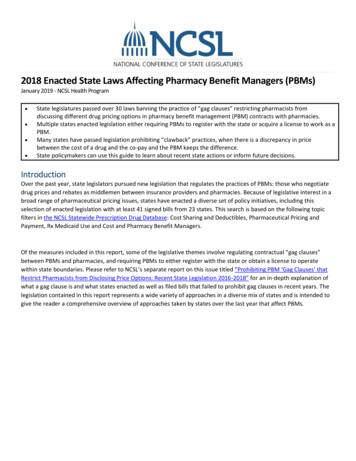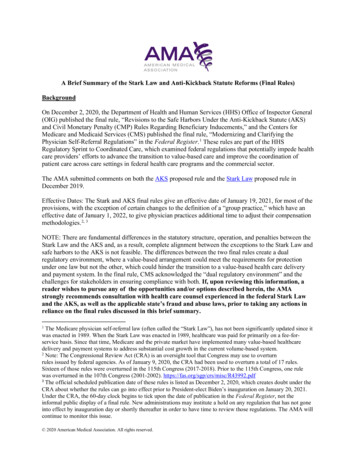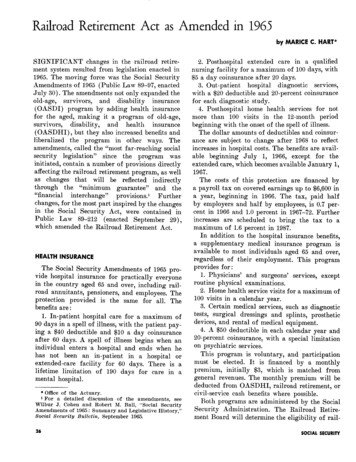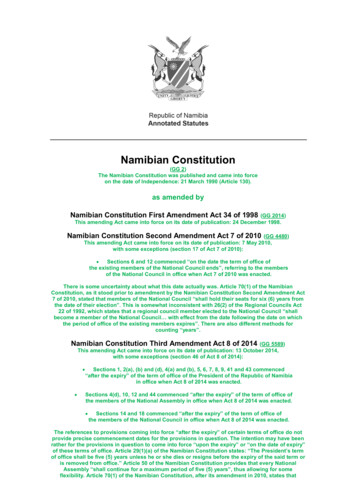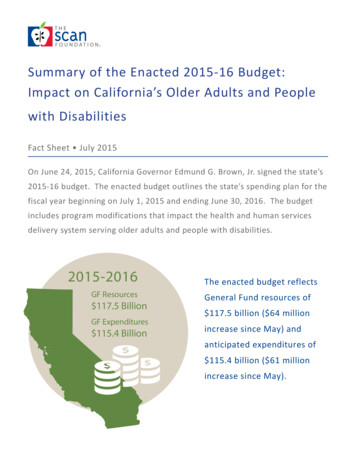
Transcription
Summary of the Enacted 2015-16 Budget:Impact on California’s Older Adults and Peoplewith DisabilitiesFact Sheet July 2015On June 24, 2015, California Governor Edmund G. Brown, Jr. signed the state’s2015-16 budget. The enacted budget outlines the state’s spending plan for thefiscal year beginning on July 1, 2015 and ending June 30, 2016. The budgetincludes program modifications that impact the health and human servicesdelivery system serving older adults and people with disabilities.2015-2016GF Resources 117.5 BillionGF Expenditures 115.4 BillionThe enacted budget reflectsGeneral Fund resources of 117.5 billion ( 64 millionincrease since May) andanticipated expenditures of 115.4 billion ( 61 millionincrease since May).
Fact Sheet July 2015OverviewThe enacted budget includes total resources of 117.5 billion General Fund (GF), total expendituresof approximately 115.4 billion GF and total reserves of 4.6 billion. The budget includes 1.1billion in the Regular Reserve and 3.5 billion in the Rainy Day Fund, as required by Proposition 2. 1New expenditures in the enacted budget for areas deemed a high priority by the legislature andthe governor are as follows: restoration of the seven percent reduction in In-Home SupportiveServices hours; Medi-Cal coverage for low-income undocumented children; additional funding forK-12 school system and community colleges; the California Earned Income Tax Credit for the state’spoorest working families; additional funding for pre-school and child care slots along with providerrate increases; and expanded enrollment for the California State University System. Additionally,Governor Brown issued proclamations to convene two special sessions of the Legislature to addressissues related to 1) health care financing focusing on the Medi-Cal program, and 2) California’sroads, transportation and infrastructure.1This fact sheet addresses budget items impacting older adults and people with disabilities includedin the 2015-16 budget.Managed Care Organization TaxBackground: The Managed Care Organization (MCO) tax, a revenue tax on Medi-Cal managed careplans authorized in Senate Bill 78 (2013), is a key financing resource for certain Medi-Cal longterm services and supports (LTSS). Half of these total funds draw down federal matching funds andreimburse Medi-Cal managed care plans for the incurred taxes. The other half of the funds willoffset GF expenditures for Medi-Cal managed care rates.2 According to federal guidance, California’scurrent MCO tax is inconsistent with federal Medicaid regulations because the tax is only applied toMedi-Cal managed care plans verses all managed care plans. The current MCO tax will no longer beallowed after it expires on June 30, 2016.3January Budget Proposal: The January budget assumed an MCO tax contribution of 803 million in2014-15 and 1.1 billion in 2015-16. In January, Governor Brown announced that the state wouldreplace the current tax with a broad-based MCO tax in 2016 that complies with federal law. This newtax would apply to all managed care plans regulated by Department of Managed Health Care and/or the Department of Health Care Services (DHCS), and must raise the same amount of general fundsavings as the current tax.3www.TheSCANFoundation.org2
Fact Sheet July 2015May Revision: The MCO tax proposal remained the same as proposed in the January budget.Enacted Budget/Special Session: The MCO tax proposal will be addressed during the special sessionfor health care financing. The special session will consider and act upon legislation necessary toenact permanent and sustainable funding through a new MCO tax and/or alternative fund sources inorder to: Stabilize Medi-Cal funding through 1.1 billion infinancing from the MCO tax; Continue restoration of seven percent reduction inIHSS service hours beyond 2015-16; and Identify funding for increased provider rates for bothproviders of Medi-Cal and developmental disabilityservices.4Governor toconvene a specialsession to addresshealth care financingfocusing on theMedi-Cal program.Long-Term Services and SupportsCoordinated Care InitiativeBackground: The Coordinated Care Initiative (CCI) changed how medical care and LTSS are providedfor low-income older adults and people with disabilities. 5,6 The main components of the CCIinclude: 1) provisions of Cal MediConnect; 2) mandatory enrollment of dual eligible beneficiaries(individuals eligible for both Medicare and Medi-Cal, California’s Medicaid program) into Medi-Calmanaged care; and 3) integration of Medi-Cal-funded LTSS into managed care. 7 The CCI will befully operational in seven counties (Los Angeles, Orange, Riverside, San Bernardino, San Diego, SanMateo, and Santa Clara) as of August 2015.3One component of the CCI is to transition the Mulitpurpose Senior Services Program (MSSP) froma federal waiver to a managed care benefit beginning January 1, 2015 or after 19 months of MSSPbeneficiary enrollment into managed care. The MSSP, a 1915(c) Medicaid waiver program, providescare management to frail older adults by connecting them with community-based services to helpthem remain in their homes.www.TheSCANFoundation.org3
Fact Sheet July 2015January Budget Proposal: The proposed budget assumed that the CCI would generate GF savings of 176.1 million in 2015-16, primarily attributed to funds generated through the MCO tax by the CCIplans. In his January budget proposal, the governor noted that implementation of Cal MediConnectas part of CCI has not aligned with the assumptions made when it was established in 2012, therebyimpacting the projected savings. Specifically, less-than-anticipated savings shared with the federalgovernment, enrollment delays, lower enrollment numbers, and higher than anticipated In-HomeSupportive Services (IHSS) costs have impacted the attributed savings. As such, the Januarybudget projected that the CCI could result in net costs to the state without solutions to improveparticipation, address the MCO tax, and lower state costs. The January budget noted that the CCIwould stop operating in January 2017 if the program does not generate sufficient savings. 3May Revision: Core elements of the CCI remained the same as indicated in the January budgetproposal. However, the governor’s May Revision proposal extended the MSSP transition deadlineto December 31, 2017, and allowed earlier transition in a county/region when MSSP sites andmanaged care plans mutually agree on the early transition. In addition, both the MSSP sites andmanaged care plans would be required to meet readiness criteria to be developed by the DHCS,California Department of Aging (CDA), MSSP providers, managed care plans, and stakeholders. 8Enacted Budget: The core elements of the CCI remainas outlined in the January budget and May Revision.Additionally, the enacted budget reflects the MSSP policychange outlined in the May Revision, with an extendedMSSP transition deadline and related readiness criteriarequirements.9Governor plans toaddress MCO taxsolution during aspecial session.In-Home Supportive Services (IHSS)Background: The IHSS program provides in-home personal care assistance to low-income adultswho are over 65 years of age, blind, or disabled, and to children who are blind or disabled. Servicesinclude assistance with bathing, feeding, dressing, and/or domestic services such as shopping,cooking, and housework so that individuals can remain safely in their own homes. County socialworkers assess individuals using a standardized assessment to determine need and then authorizeservice hours per month based on functional need. IHSS is expected to serve 463,000 recipients permonth on average in 2015-16.3www.TheSCANFoundation.org4
Fact Sheet July 2015January Budget Proposal: The proposed budget included 8.2 billion ( 2.5 billion GF) for the IHSSprogram in 2015‑16, a 14.4 percent increase over the revised 2014‑15 level. Restoration of Seven Percent Across-the-Board Reduction: The budget proposed to restorethe current seven percent across‑the‑board reduction in service hours with proceeds from therevised MCO tax, effective July 1, 2015. The cost to restore the seven percent reduction wereestimated to be 483.1 million in 2015‑16.3 Federal Overtime Regulations: A federal district court ruled that a portion of the U.S.Department of Labor Fair Labor Standards Act (FLSA) rule requiring overtime pay for domesticworkers exceeded the Department of Labor’s authority and thus halted implementationof the regulations.* Therefore, the state halted implementation of overtime and relatedrequirements, including compensation for providers traveling between multiple IHSSrecipients, wait time associated with accompanying recipients to medical appointments, andtime spent in mandatory provider training.3,10May Revision: Restoration of Seven Percent Across-the-Board Reduction: The proposal to restore the sevenpercent across-the-board reduction in IHSS service hours beginning July 1, 2015 remained inthe May Revision.11 IHSS Caseload: The May Revision reflected an increase of 147.6 million GF in 2014-15 and 179.1 million GF in 2015-16, primarily associated with increases in the number of peopleenrolled, hours authorized, and wage increases. FLSA Rule: To date, none of the 2014-15 funds designated to implement the overtime rulehave been spent. Senate Bill 855 included a provision requiring that any unspent FLSA-relatedfunding in the current year resulting from delayed federal implementation of the rule areused for other purposes within the IHSS program. The May Revision applied these one-timeunspent funds to partially offset the 326.7 million in increased IHSS costs related to caseload,hours per case, and costs per hour. The May Revision continued to assume full-year fundingof 316 million GF in 2015-16 for implementation of the federal rule, pending further legaldevelopments.12* In 2013, the United States Department of Labor announced new regulations that require overtime pay for domestic workers,compensation for providers who travel between multiple recipients, for wait time associated with medical accompaniment, andfor time spent in mandatory provider training.www.TheSCANFoundation.org5
Fact Sheet July 2015Enacted Budget: The enacted budget reflects all of the policy changes outlined in the May Revision,along with the following specifications: Restoration of Seven Percent Across-the-BoardReduction: Approves restoration of the sevenpercent reduction in IHSS hours, effective July 1,2015 for 226 million GF in 2015-16. An ongoingfund source will be addressed through a speciallegislative session on health care financing. 1,13 FLSA Rule: Approves proceeding with theimplementation of overtime for IHSS, and includes 270 million GF in 2015-16 with an assumedOctober 1, 2015 effective date if the federal ruleis upheld.1Identifying anongoing fundingsource for restorationof IHSS hours willbe addressed in thespecial session onhealth care financing.Health Homes ProgramBackground: Chapter 642, Statutes of 2013 (AB 361), permits DHCS to develop the Health HomesProgram that would enhance care management and coordination for beneficiaries with complexneeds. Upon implementation, the program seeks to provide comprehensive care management, carecoordination, health promotion, comprehensive transitional care, individual and family support, andreferral to community and social support services. The program will be funded primarily throughfederal funds, with non‑federal funding coming from non‑state sources.May Revision: A May Revision proposal included budget and spending authority for 61.6 millionin non-state funds for additional payments to health plans that participate in the Health HomesProgram beginning January 2016.12Enacted Budget: The enacted budget includes 61.6 million in non-state funds for additionalpayments to health plans that participate in the Health Homes Program beginning January 2016. 1,9www.TheSCANFoundation.org6
Fact Sheet July 2015Other Medi-Cal ProposalsAnnual Open Enrollment for Specified Medi-Cal Managed Care EnrolleesBackground: Currently, people using Medi-Cal are able to switch health plans each month.January Budget Proposal: The governor’s budget proposed an annual open enrollment periodfor certain Medi-Cal beneficiaries who are required to enroll in a Medi-Cal managed careplan. However, older adults, people with disabilities, people fully eligible for both Medi-Caland Medicare, people in counties with only one Medi-Cal health plan, and adults newly eligiblethrough the Affordable Care Act expansion are excluded, and not impacted by the more restrictedenrollment opportunities of this proposal. Individuals can still apply for and be newly enrolled inMedi-Cal at any time during the year.14May Revision: The annual open enrollment proposal remained as indicated in the January budgetproposal.Enacted Budget: The enacted budget does not include the governor’s proposal to limit Medi-Calmanaged care enrollment to an annual open enrollment period, for a cost of 1 million GF. 15Skilled Nursing Facility Quality Assurance FeeBackground: Current law authorizes a quality assurance fee on skilled nursing facilities thatleverages additional federal funding to offset GF expenditures in these facilities. Authority for thecurrent quality assurance fee lasts through July 31, 2015, and includes a three percent increase inreimbursement rates in 2013-14 and 2014-15.January Proposed Budget: The governor’s budget proposed continuation of the quality assurancefee for an additional five years, including annual rate increases of 3.62 percent beginning in August2015.3May Revision: The Skilled Nursing Quality Assurance Fee remained as indicated in the Januarybudget proposal.www.TheSCANFoundation.org7
Fact Sheet July 2015Enacted Budget: The enacted budget approves the extension of the quality assurance fee throughJuly 31, 2020, including an annual rate increase of 3.62 percent, and other specifications asoutlined.1,16Other Program ChangesSupplemental Security Income/State Supplementary Payment (SSI/SSP)Background: The federal SSI program provides a monthly cash benefit to eligible aged, blind, anddisabled persons who meet the program’s income and resource requirements. The federal SocialSecurity Administration (SSA) administers the SSI/SSP program, making eligibility determinations,grant computations, and issuing combined monthly checks to recipients. In California, the SSIpayment is augmented with an SSP grant. The SSA applies an annual cost‑of‑living adjustment(COLA) to the SSI portion of the grant equivalent to the year-over-year increase in the ConsumerPrice Index. Effective January 2015, maximum SSI/ SSP grant levels are 881 per month for anindividual and 1,483 per month for couples. The average monthly caseload in this program isestimated to be 1.3 million recipients in 2015-16, a slight increase over the 2014‑15 projected level.January Budget Proposal: The proposed budget included a 2.8 billion GF for the SSI/SSP program,including the federal cost-of-living adjustment for SSI/SSP recipients (1.7 percent for 2015 and aprojected 1.5 percent for 2016). These changes keep the SSI/SSP grant levels at their minimumas allowed under federal law for both couples and individuals in order to maintain eligibility forMedicaid funding.3,17May Revision: Based on an adjustment of the federal Consumer Price Index, the SSA eliminatedthe 2016 COLA of 1.5 percent to individuals and couples. The May Revision reflected this federalchange.18Legislative Conference Report: The first budget sent to the governor, referred to as the ConferenceReport, included a 10 per month increase to the SSI/SSP grants to individuals (excluding couples)in an amount equal to 66 million GF for 2015-16, starting on January 1, 2016, with full-year costsof 132 million GF for 2016-17 and ongoing. However, this increase was not included in the finalbudget agreement between the Governor and the Legislature.19www.TheSCANFoundation.org8
Fact Sheet July 2015Enacted Budget: The enacted budget includesthe federal cost-of-living adjustment for all SSI/SSP recipients, as adjusted in the May Revision (1.7percent for 2015 and zero percent for 2016).18SSI/SSP recipientswill receive a cost-ofliving adjustment in2015, but not in 2016.Community Care LicensingBackground: The CDSS Community Care Licensing (CCL) Division oversees the certification ofapproximately 66,000 licensed community care facilities, including residential care facilities forthe elderly, adult residential facilities, child care centers, family child care homes, as well as fosterfamily and group homes. Prior to 2002-03, most facilities licensed by CCL were required to bevisited annually. Budget related legislation enacted in 2003 lengthened the intervals between visitsfor most facilities from one year to five years.20The enacted 2014-15 budget included funding for quality enhancement and program improvements,as well as a 10 percent increase for licensing fees in order to improve the structure of the CCLprogram.21January Budget Proposal: The proposed 2015-16 budget included 3 million GF and 28.5 statepositions to address a backlog of facility complaint cases and expand training and technicalassistance to implement quality enhancement and program improvements. Under this proposal,beginning in January 2017, DSS would begin increasing inspection frequency to every three yearsfor all facilities, every two years by 2018 for all facility types except child care, and annually by2019 for adult day care and residential care facilities for the elderly, with ongoing GF expenditurestotaling 14 million.3May Revision: The CCL proposal remained as indicated in the January budget proposal.Enacted Budget: The enacted budget approves the governor’s proposal for Community CareLicensing, with 3 million GF and 28.5 positions, increasing in later years, to address a backlog ofcomplaint cases and expand training and technical assistance in CCL. Beginning in January 2017,DSS will increase inspection frequency to every three years for all facilities, every two years by 2018for all facility types except child care, and annually by 2019 for adult day care and residential carefacilities for the elderly. The ongoing staffing costs after full implementation will be approximately 14 million GF, with a total of 145 new permanent positions approved to achieve this new licensingstandard.1www.TheSCANFoundation.org9
Fact Sheet July 2015Developmental Center ClosuresBackground: In January 2014, The Plan for The Future of Developmental Centers in California,recommended that the state should plan to close the remaining developmental centers and operatea limited number of safety-net crisis and residential centers.May Revision: The governor proposed that the state initiate planning for closure of SonomaDevelopmental Center by 2018, and Fairview and Porterville Developmental Centers by 2021. TheMay Revision included 49.3 million ( 46.9 million GF) to develop community resources to supportthe transition of Sonoma residents into the community. 12Enacted Budget: The enacted budget anticipates the closure of the Sonoma Developmental Centerby the end of 2018, and plans for the closure of the Fairview Developmental Center and the nonsecure treatment portion of the Porterville Developmental Center, with the last closure completedin 2021. In preparation for the closure of the Sonoma Developmental Center, the budget includes 49.3 million ( 46.9 million GF) to support the transition of Sonoma residents to communitysettings. These resources will support the initial development of homes to support consumers,provide additional training for providers, and other programs including supported living services,crisis services, and transportation support.1Additional Items in the Enacted BudgetLong-Term Care OmbudsmanThe Long-Term Care Ombudsman program investigates and endeavors to resolve elder abusecomplaints made by, or on behalf of, residents in long-term care facilities including nursinghomes and residential care facilities for the elderly (e.g, assisted living facilities). The enactedbudget includes 2.4 million ( 1 million GF) to increase unannounced facility monitoring visitsand complaint investigations and increase the recruitment, supervision, and training of paid andvolunteer Ombudsman representatives.1www.TheSCANFoundation.org10
Fact Sheet July 2015Caregiver Resource CentersCaregiver Resource Centers serve families and caregivers of individuals with chronic ordegenerative cognitive disorders that affect adults, such as Alzheimer’s, stroke, or traumatic braininjury. Through eleven locations across the state, the program provides information and referral,consultation, respite care, counseling and other services to family caregivers. The enacted budgetaugments the Caregiver Resource Centers budget by 2 million GF, for a total funding level of 4.9million GF.1Medi-Cal Provider Rate IncreaseThe enacted budget repeals the AB 97 (2011 budgettrailer bill) 10% rate cut for dental providers, effectiveJuly 1, 2015. Beyond dental rates, the enacted budgetprovides no rate increases to other Medi-Cal providersas part of the budget package, and defers the issue tothe special session on health care financing. 1www.TheSCANFoundation.orgGovernor includedincreased fundingin the budget forLong-Term CareOmbudsman programand CaregiverResource Centers.11
Fact Sheet July 2015References1.California Department of Finance. California 2015-16State Budget. 2015; 2015.pdf. Accessed June 28, 2015.12. California Department of Finance. 2015-16 May Revision.2015; http://dof.ca.gov/documents/2015-16 May Revision.pdf. Accessed May 14, 2015.2.The SCAN Foundation. Summary of the Enacted 2013-2014 Budget:Implications for Older Adults and People with Disabilities. ndation.org/files/tsf-fact-sheet-ca budget final-2013-2014 1.pdf. Accessed May 14,2015.13. Senate Bill 97 (Chapter 11, Statutes of 2015).3.4.California Department of Finance. 2015-16 Governor’s BudgetSummary. 2015; y/FullBudgetSummary.pdf. Accessed May 14, 2015.State of California Executive Department. A Proclamation bythe Governor of the State of California. 2015; http://gov.ca.gov/docs/6.16.15 Health Care Special Session.pdf. Accessed June 28,2015.14. California Department of Health Care Services. 2015-2016Governor’s Budget Highlights. 2015; ighlights.pdf. Accessed May14, 2015.15. Assembly Budget Committee. Updated Floor ReportReflecting AB 93 as Amended by AB 123/SB 97 2015-16Budget,. 2015; 20%20Post%20June%2015%2C%202015.pdf. Accessed June 28, 2015.16. AB 119 (Chapter 17, Statutes of 2015).5.Senate Bill 1008 (Chapter 33, Statutes of 2012).6.Senate Bill 1036 (Chapter 45, Statutes of 2012).7.The SCAN Foundation. California’s Coordinated Care Initiative:Background and Overview. 2012; view. Accessed May 14, 2015.8.9.California Department of Health Care Services. Departmentof Health Care Services Proposed Trailer Bill Legislation; 650 Multipurpose Senior Services Program Transition Timeline. 2015;http://www.dof.ca.gov/budgeting/trailer bill language/healthand human ccessed May 15, 2015.Senate Bill 75 (Chapter 18, Statutes of 2015).10. California Department of Social Services. State HaltsImplementation of Overtime for In-Home Supportive Services.2014; ease/Judges Ruling Vacates.pdf. Accessed May 14, 2015.11. Assembly Budget Committee. Highlights of Governor’sProposed 2015-16 May Revision. 2015; inal%29.pdf. Accessed May 14, 2015.17. Assembly Budget Committee. Highlights of Governor’sProposed 2015-2016 Budget. 2015; s.pdf. Accessed May 14, 2015.18. California Department of Social Services. Local AssistanceEstimates for the 2015-16 Governor’s Budget. 2015; http://www.cdss.ca.gov/cdssweb/PG3682.htm. Accessed June 30,2015.19. Assembly Budget Committee. Floor Report 2015-16 Budget.2015; f.Accessed June 28, 2015.20. Assembly Budget Subcommittee No. 1 on Health and HumanServices. Agenda: Assembly Budget Subcommittee No. 1on Health and Human Services. 2014; CS.pdf. Accessed May14, 2015.21. California Department of Finance. California State Budget2014-15. 2014; http://govbud.dof.ca.gov/FullBudgetSummary.pdf. Accessed June 20, 2014.For more information, contact Megan Burkeat orgLike us on FacebookFollow us on Twitter12
percent reduction in IHSS hours, effective July 1, 2015 for 226 million GF in 2015-16. An ongoing fund source will be addressed through a special legislative session on health care financing.1,13 FLSA Rule: Approves proceeding with the implementation of overtime for IHSS, and includes 270 million GF in 2015-16 with an assumed



